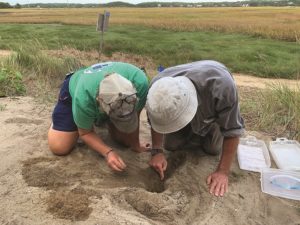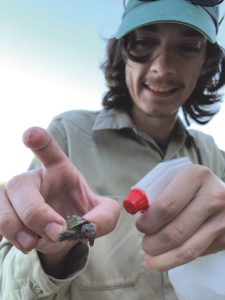WELLFLEET — The day after Hurricane Ida’s rainy remnants swept across the Cape on Sept. 2, Jessica Ciarcia of Massachusetts Audubon arrived on Lieutenant Island for a diamondback terrapin monitoring shift. A single glance at the first “turtle garden” — stretches of sand embedded with protected terrapin nests — prompted her to clack out an S.O.S. email. Ida had unleashed a record number of terrapin hatchlings from their nests, and Ciarcia needed reinforcements.
Within 30 minutes, nearly a dozen cars rumbled over the Lieutenant Island wooden bridge and crammed along the parking area. Ciarcia assumed the role of an incident command officer, directing crews of three, armed with bundles of equipment, to the nests. Volunteers excavated hatchlings from the sand, sprayed them down, jotted down measurements, and prepped the baby turtles for release. Meanwhile, turtles were emerging in droves at other protected sites along the Outer Cape’s bay side.
During that post-Ida “gold rush,” as one volunteer put it, Audubon teams released 233 terrapins. Bob Prescott, the emeritus director of Mass Audubon’s Wellfleet Bay Wildlife Sanctuary, called that day the “biggest event we’ve ever had in the history of the program.
“That rain came at the right time,” he said. “And the turtles were ready.”
The 2021 hatchling monitoring season has come to a close with a program-record-breaking tally of 5,162 released hatchlings from 419 terrapin nests protected by volunteers.
Taft’s Lunch
Designated a threatened species in Massachusetts, diamondback terrapins sustained a heavy blow in the 1930s, when barrels of them were shipped from Cape Cod’s wild turtle fisheries to Maryland, where they were a “big delicacy,” said Prescott.
In her book Diamonds in the Marsh, Barbara Brennessel, a Wellfleet biologist and terrapin researcher, described two popular terrapin dishes. Some preferred to roast the turtles and eat them straight from the shell, while others leaned toward soups. Among the soup-eaters was President Howard Taft, whose favorite White House lunch course was often paired with champagne. (And he “had the waistline to prove it,” Brennessel added.)
Catching terrapins involved skimming the edge of the marsh, a long pole in hand. Turtle hunters would plunge this into the mud, and a thunk meant a turtle was within reach. Back then, each female was worth the equivalent of $30 today — a “big payday in November for fishermen who weren’t going to get a paycheck for the rest of the winter,” Prescott said.
Eventually, the terrapins were overharvested. “Barnstable, Pleasant Bay, and Wellfleet Harbor were totally depleted,” Prescott said.
In Massachusetts, the diamondback terrapin was later listed as a “threatened” species, and to this day, adults, eggs, and juveniles are protected from hunting, fishing, and trapping; disturbing or harassing the species is also illegal. While the shipments to Maryland have ceased, habitat reduction remains a problem. Another hazard: summer traffic. Compared to males, females roam farther and are more likely to be struck by cars. And with human habitation come more foxes, raccoons, and skunks — the turtles’ main predators.
Traps for green crabs were, not so long ago, another threat. Prescott recognized that fact during a walk around Wellfleet Harbor in the 1980s. Shellfishermen were, at the time, permitted to trap green crabs, an invasive species that preys on oysters.
“Every time I looked into a trap, there were dead terrapins,” Prescott said. “I needed to blow the whistle, saying we needed to save this threatened species from being caught and killed.
“Of course,” he added, “that didn’t make me very popular around town.” At first, he was blamed for oyster mortality caused by green crabs. Eventually, he reached shellfishermen with his message that “the best green crab trap is the diamondback terrapin. You’re killing the thing that’s eating the oyster predator.”

In the 1990s, terrapin conservation gained momentum at the sanctuary after Prescott and his staff decided to dig turtle gardens. The idea sprang from a chat with a golf course superintendent who asked him how to stop snapping turtles from nesting in the sand traps. Curious, Prescott asked a summer intern to prepare a sandy patch, and, to Prescott’s surprise, the “turtles went right to it,” he said — but predators soon ravaged the nest.
Back at the drawing board, Prescott’s staff experimented with wire cages to protect the nests. The mammals were thwarted, but then crows began poking their beaks through the openings and plucking baby turtles. The solution was plastic mesh crow guards.
Brennessel soon joined the team, along with Don Lewis, a volunteer who led the charge on a population study that described the Outer Cape terrapins’ numbers, gender ratios, and age distributions. Her book describes Lewis as having a photographic memory. “He can usually remember each terrapin, where it was captured and the circumstances of the day,” wrote Brennessel. “He also has an uncanny ability to recall the weights and measurements of some of the turtles.”
Together, they built up a “critical mass” of volunteers and citizen scientists, and the Audubon’s terrapin effort bloomed into today’s annual nest monitoring program.
Rescue Shift
On a recent Thursday evening shift at Lieutenant Island, Lesa Milas, a former biology teacher who has been volunteering for eight years, was in charge. “Sharing science with people has been a part of my life for 35 years — and it’s not going to change,” she said.
She led a small group of volunteers and staff around the salt marsh, peering through the wiring around protected nests for any signs of hatchlings ready to be released into the wild. Some terrapins were out and about on the sand. Elsewhere, divots in the earth suggested turtles’ hiding places below. Where there was a divot, a turtle may have popped its head out, decided the day was “too cruel,” Milas explained, then receded into the nest chamber to huddle with its siblings.

In these cases, volunteers pulled back the crow guard, removed the caging, and sifted through the sand, often finding a dozen or so healthy terrapin hatchlings. After receiving squirt-bottle showers to remove sand, they were tucked into plastic bins. Dylan Marat, a research technician at the sanctuary, would take the hatchlings to the wet lab for the night, where they’d be sheltered from nocturnal predators, and the morning shift would release them.
From time to time, maggots beat humans to the punch, infesting the chamber and devastating the eggs. Dune grass can also doom a clutch: its roots can penetrate the leathery eggshells and sap nutrients from the yolk, sometimes even strangling nearly developed hatchlings.
Scouting beyond the protected turtle gardens, Milas has developed a keen radar for finding wild nests unknown to the sanctuary team. Certain bumps in the sand can hint at a hidden nest, and she has her eyes peeled for terrapin tracks, recognizable by footprints and a distinct drag mark left by the tail. “I still get a thrill every time I find a nest,” she said. “And then, by protecting it, we give them a better chance at making it.”
After helping with the Thursday evening shift, John Grieb, who retired from a career in public health, returned to help with morning releases. He took the hatchlings out to designated sites, dug down into the underbrush, and ensured the soil was moist enough. Gingerly, he placed terrapins no less than five feet from each other. Too close and raccoons may come scampering for a buffet. Next, he said, “Basically, you cover them up, and you tell them, ‘Have a good life!’ ”
From there, the terrapins begin what researchers call their “lost years.” The first four to five years of their lives are, as Brennessel wrote, “a black hole in terrapin life history.” They disappear for a few years and are seen again only when they are larger.
“They mature at 10 years,” said Prescott. “When they finally get out into Wellfleet Harbor, they’re teenagers.”
For some of the volunteers, turtle season is just getting started. Cold-stunned sea turtle rescues will begin soon. Just last week, Prescott slogged into the muddy water of the Herring River to rescue a stranded leatherback. With other volunteers, he hauled it onto a stretcher by the shore and trekked up someone’s driveway. A car took it to Provincetown, where “it walked into the water,” Prescott said. “And off it went!”
